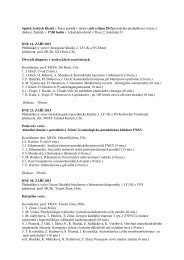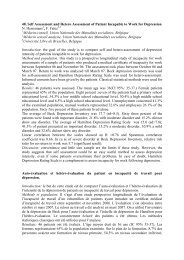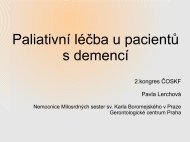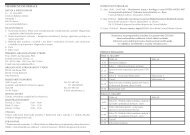ABSTRACTS â ORAL PRESENTATIONS - AMCA, spol. s r.o.
ABSTRACTS â ORAL PRESENTATIONS - AMCA, spol. s r.o.
ABSTRACTS â ORAL PRESENTATIONS - AMCA, spol. s r.o.
You also want an ePaper? Increase the reach of your titles
YUMPU automatically turns print PDFs into web optimized ePapers that Google loves.
50. THE PROGRESSION OF HIV INFECTION IN TERMS OF LABORATORY IMMUNOLOGY<br />
Alexandra Lochmanová 1 , Lenka Olbrechtová 2 , Jitka Kolčáková 2 , Alena Zjevíková 2<br />
1<br />
Institute of Public Health, Department of Immunology and Allergy, Ostrava, Czech<br />
Republic; alexandra.lochmanova@zuova.cz<br />
2<br />
Faculty Hospital Ostrava, Clinic of Infectious Medicine, Czech Republic<br />
The pathogenesis of HIV infection includes depletion of the total body CD4+ T-cell pool,<br />
leading to immunodeficiency. This effect is accompanied by activation of numerous<br />
elements of immune system. Immune activation appears to be driven by both<br />
homeostatic response to CD4+ T/cell depletion and an inflammatory response to HIV<br />
infection.<br />
The correlation between peripheral blood CD4+ counts and the spectrum of clinical<br />
manifestations of HIV disease is well defined and has been recognized for many years.<br />
Despite its value, the peripheral blood CD4+ count is recognized as an imperfect marker<br />
of HIV disease progression. In some cases, the CD4+ percentage is a better marker of<br />
immune competence than CD4+ count.<br />
Measurements of T-cell function seems to be more effective and central to understanding<br />
HIV disease. Three types of assays are typically used to measure T-cell function:<br />
cytotoxicity, proliferation and cytokine secretion. Nonproliferation-base assessments<br />
of immune activation include measuring expression of so-called “early” cell surface<br />
markers such as HLA-DR, CD38, CD69 or CD25. A proliferative state as a definitive<br />
indicator of activation accompanied by DNA synthesis can be assessed by 3 H-thymidine<br />
uptake, measurements of intracellular proteins such as Ki67 or staining with tracking<br />
dyes (CFSE).<br />
Chronic HIV infection is accompanied by permanent activation of immune system a<br />
persistent inflammation. The intensity of this process is associated with serious outcome<br />
and poor prognosis. One of the most effective cytokine in thi sproces is IL-2, which is a<br />
potent inducer of T-cell proliferation and participates in both induction and suppression<br />
of inflammatory process.<br />
Routine laboratory monitoring of HIV patients involves determining peripheral blood<br />
CD3+, CD3+ CD4+ and CD3+CD8+ absolute count and T-cell proliferation measured by<br />
3<br />
H-thymidine incorporation after stimulation with PHA.<br />
It was show that the degree of cell activation, resp. functional activity, clearly reflects<br />
the depth of immunodeficiency. Reduction of functional activity indicates impairment<br />
of immune competence, whose improvement can be achieved therapeutically. Longterm<br />
unresponsiveness suggests a definite loss of immune competence and appears<br />
in the terminal stage of the disease. Impaired ability of lymphocyte proliferation may<br />
be caused by a lack of synthesis of ribonucleotides due to defect of relevant metabolic<br />
pathways. However, IL-2 seems to be one of the most important components of this<br />
process because IL2 is essential for lymphocyte proliferation. In accordance with these<br />
findings correspond clinical studies which indicate that administration of recombinant<br />
IL2 leads to a permanent increase in the number and function of CD4 + T cells in patients<br />
in both early-and late-stage of HIV infection.<br />
64 Analytical Cytometry VII








